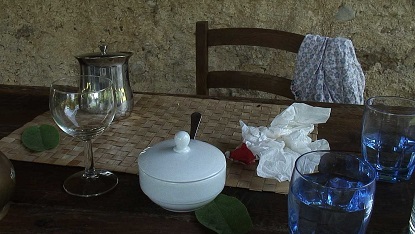
Roman Diary
DCP, 124 minutes, 16:9, colour, stereo
Rome 1849, Rome 2010, encounters with Giuseppe Garibaldi’s „Thousands“ and oneself.
„Silently the stone witnesses remain still in a Roman park, the past reaching far into the
present. Embedded between the images, Rembrandt’s questioning gaze onto himself. Then the rhythm
changes, life comes crashing in; people gather in the park under the night sky. In the end – still lifes,
the mysterious workings of objects. Below it all, the city.“
Tina Glaser, Vienna, June, 2011
Like all of the films I have made since „Heaven and Earth“ (1982), ROMAN DIARY is in a way a tantric exercise or meditation, as defined by one of the oldest tantric texts, the Vijnana Bhairava. If you watch a film in order to „learn“ something, then this film is not for you. But if you want to test out what it is possible to experience through film, then this is the right medium for you. Using techniques such as extreme slow motion and irrational, poetic contrast, it is a tool you can use to centre yourself, for it speaks more to the heart than the head. What kind of experience it offers depends on you. If you remain open with heart and mind, and accept what the film offers, it will bring you closer to your inner self. But if you activate your critical self, then nothing will enter you. In a way it is a film for meditation. Meditation does not help you to become a Buddha, but it helps you to become aware that you are already a Buddha. Since meditation and love are close to each other and love does not follow a purpose but is always there: simply be present. Without paying attention to your mind stay with the film, and see what takes place ...Michael Pilz, Andra Pradesh/India, 17 December, 2011
Every true artist connects with their own unconscious, at times with the collective unconscious, as well, and draws on the depths of their own being without being able to say in advance what is going to rise to the surface from the deep. The process of emergence cannot be clad in the corset of a concept, in the framework of imaginary ideas. To a large extent, it has to be and remain a speculative venture that involves a great deal of risk. Because human nature generally tends to confine, control, and gain power over everything that's alive. The driving forces behind this are feelings of anxiety, ultimately fears of losing life itself. Any truly creative process touches on these ultimate questions, and the more openly and fearlessly it does so, the deeper and more convincing the ensuing work will appear to others.
Michael Pilz, Retrospective 2023, Vienna
Original title Roman Diary
Produced by Michael Pilz
Shooting time 2010
Shooting locations Rome/Trastevere/Gianicolo, Monti Sabini
Cinematography by Michael Pilz
Original Sound by Michael Pilz
Edited by Michael Pilz
Music by Andrew Blissett, Leonard Cohen, Lama Gyurme, Tom Kenyon, Jean-Philippe Rykiel, Franz Schubert, Mario Tiberi & Canto Armonico, Song „A Hundred Thousand Angels“ written and performed by Lucinda Drayton and Andrew Blissett, www.lucindadrayton.com
Sound Mix by Michael Pilz
No dialogues, no subtitles
Thanks to Gideon Bachmann, Levi Bachmayr, Andrew Blissett, Sabine Brocza, Leonard Cohen, Lucinda Drayton, Fausto Giotti, Paola Guabagnoli, Lama Gyurme, Gabriele Hochleitner, Jon Jost, Tom Kenyon, Gerhard Kury, Roberta Leoni, Sarah Virginia Morgan, Andrew Mutter, Rudolf Ortner, Guillermo Otálora, The People of the City of Rome, Thomas Rauser, Jean-Philippe Rykiel, Peter Schreiner, Franz Schubert, Mario Tiberi & Canto Armonico
Austria 2011
Financial support 
First public screening 41th International Film Festival Rotterdam, January 2011
Festivals, specials Rotterdam (NL), New York (Anthology Film Archives), Buenos Aires BAFICI
Distribution by Michael Pilz Film
A-1180 Vienna/Austria
Teschnergasse 37
Phone +43.699.11336581